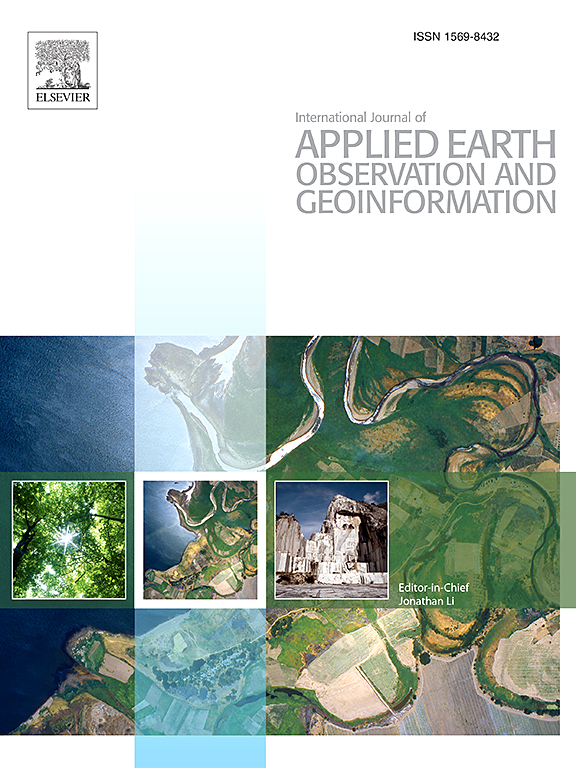UAV-StrawFire:一个可见光和红外数据集,用于实时秸秆火灾监测,具有深度学习和图像融合
IF 8.6
Q1 REMOTE SENSING
International journal of applied earth observation and geoinformation : ITC journal
Pub Date : 2025-05-30
DOI:10.1016/j.jag.2025.104586
引用次数: 0
摘要
秸秆焚烧在特定季节排放有害污染物,对当地空气质量和附近公众健康构成重大威胁。传统的卫星遥感技术由于重访间隔时间长、空间分辨率低,在监测小规模秸秆焚烧事件方面存在困难。为了应对这一挑战,配备成像传感器的无人驾驶飞行器(uav)已经成为一种快速且经济高效的监测和探测秸秆火灾的解决方案。本文介绍了无人机秸秆燃烧数据集,该数据集包括RGB图像、热红外图像和在中国南方使用无人机进行的可控秸秆燃烧实验中拍摄的视频。数据集被注释和标记,以支持检测、分割和跟踪算法的应用。本研究使用数据集解决了三个关键的机器学习任务:(1)火焰检测,通过基于特征的多模态图像融合模型(FF-YOLOv5n)实现,mAP50-95为0.5764;(2)火焰分割,利用实时轻量级的BiSeNetV2模型划定火界,实现了较高的平均mIoU分数,超过0.88;(3)火焰跟踪,采用Aba-ViTrack算法对秸秆燃烧过程进行实时监控,精度为0.9065,成功率为0.6593,适用于50帧/秒(FPS)的无人机机载处理。这些实验为具有边缘计算能力的无人机秸秆焚烧监测提供了有效的基线模型。无人机秸秆火数据集能够检测和监测不同大小、纹理和不透明度的火焰区域,从而支持潜在的秸秆燃烧控制工作。该数据集在IEEE数据端口上公开提供,为遥感和机器学习社区的研究人员提供了宝贵的资源,以推进有效的秸秆燃烧监测系统的开发。本文章由计算机程序翻译,如有差异,请以英文原文为准。
UAV-StrawFire: A visible and infrared dataset for real-time straw-fire monitoring with deep learning and image fusion
Straw burning poses significant threats to local air quality and nearby public health by emitting harmful pollutants during specific seasons. Traditional satellite-based remote sensing techniques encounter difficulties in monitoring small-scale straw-burning events due to long revisit intervals and low spatial resolution. To address this challenge, unmanned aerial vehicles (UAVs) equipped with imaging sensors have emerged as a rapid and cost-effective solution for monitoring and detecting straw fires. This paper presents the UAV-StrawFire dataset, which comprises RGB images, thermal infrared images, and videos captured during controlled straw residue burning experiments in southern China using drones. The dataset is annotated and labeled to support the application of detection, segmentation, and tracking algorithms. This study addresses three key machine learning tasks using the dataset: (1) flame detection, achieved through a feature-based multi-modal image fusion model (FF-YOLOv5n) reaching a mAP50-95 of 0.5764; (2) flame segmentation, which delineates fire boundaries using the real-time lightweight BiSeNetV2 model, achieving a high mean Intersection over Union (mIoU) score exceeding 0.88; and (3) flame tracking, which monitors the real-time progression of straw burning with a precision of 0.9065 and a success rate of 0.6593 using the Aba-ViTrack algorithm, suitable for on-board processing on UAVs at 50 frames per second (FPS). These experiments provide efficient baseline models for UAV-based straw-burning monitoring with edge computing capabilities. The UAV-StrawFire dataset enables the detection and monitoring of flame regions with varying sizes, textures, and opacities, thereby supporting potential straw-burning control efforts. The dataset is publicly available on IEEE Dataport, offering a valuable resource for researchers in the remote sensing and machine learning communities to advance the development of effective straw-burning monitoring systems.
求助全文
通过发布文献求助,成功后即可免费获取论文全文。
去求助
来源期刊

International journal of applied earth observation and geoinformation : ITC journal
Global and Planetary Change, Management, Monitoring, Policy and Law, Earth-Surface Processes, Computers in Earth Sciences
CiteScore
12.00
自引率
0.00%
发文量
0
审稿时长
77 days
期刊介绍:
The International Journal of Applied Earth Observation and Geoinformation publishes original papers that utilize earth observation data for natural resource and environmental inventory and management. These data primarily originate from remote sensing platforms, including satellites and aircraft, supplemented by surface and subsurface measurements. Addressing natural resources such as forests, agricultural land, soils, and water, as well as environmental concerns like biodiversity, land degradation, and hazards, the journal explores conceptual and data-driven approaches. It covers geoinformation themes like capturing, databasing, visualization, interpretation, data quality, and spatial uncertainty.
 求助内容:
求助内容: 应助结果提醒方式:
应助结果提醒方式:


